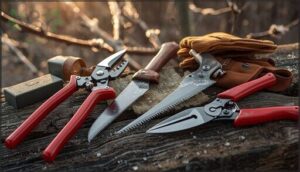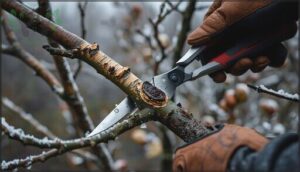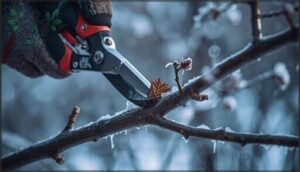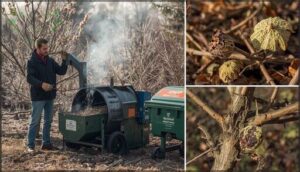This site is supported by our readers. We may earn a commission, at no cost to you, if you purchase through links.

Your garden looks quiet in winter, but beneath that stillness, something powerful is happening. Deciduous trees and shrubs rest in dormancy, their energy stores shifting underground, while their branch architecture stands fully visible—no leaves to hide weak limbs, crossing branches, or disease damage.
This narrow window offers the cleanest opportunity all year to reshape your landscape with precision. Studies show that dormant-season cuts redirect spring energy exactly where you want it, boosting shoot length by 18% and slashing disease transmission by up to 15% compared to growing-season work.
The trick lies in timing your cuts when temperatures hover just above freezing, the wood stays dry, and your plants can seal wounds before pathogens strike. Master these winter garden dormant pruning tips, and you’ll set the stage for vigorous growth, healthier blooms, and a more resilient landscape when spring finally breaks.
Table Of Contents
Key Takeaways
- Winter dormancy offers the cleanest window to prune deciduous trees and shrubs because bare branches expose weak limbs, crossing wood, and disease damage that foliage would otherwise hide during the growing season.
- Pruning during dormancy redirects stored root energy precisely where you want it, delivering measurably stronger results—18% longer shoots, up to 30% more flower buds, and 15-25% lower disease transmission compared to growing-season cuts.
- Timing your cuts on mild, dry days above freezing when plants are fully dormant maximizes wound healing and minimizes pathogen spread, while pruning during extreme cold or wet conditions invites frost damage and fungal infections.
- Limit winter pruning to 25-30% of the canopy and always use sharp, sterilized tools to make clean angled cuts just outside the branch collar, ensuring faster recovery and protecting long-term plant vigor.
Benefits of Dormant Winter Pruning
Pruning during winter dormancy isn’t just about tidying up your garden—it sets the stage for vigorous growth and vitality when spring arrives. When you prune while plants are dormant, you’re working with their natural rhythms to optimize recovery and minimize stress.
Let’s look at the key advantages that make winter the ideal time to reach for your pruning shears.
Improved Plant Recovery and Spring Growth
Timing your pruning during dormancy unleashes the plant’s full regenerative power. When you cut in winter’s rest, you’re setting the stage for a brilliant comeback. Dormant care redirects energy straight to those spring buds that’ll burst forth with 18% longer shoots—a measurable growth enhancement that proves your pruning techniques matter.
Why winter pruning tips consistently deliver better plant health:
- Your cuts heal faster with stored root energy fueling recovery
- Reduced canopy density improves light penetration by 12–22%
- Pruning timing during the dormant season cuts disease risk by 9–15%
- Uniform bud break increases yield consistency by 5–8% across varieties
By following a systematic review process, gardeners can make informed decisions to refine their pruning techniques.
Enhanced Disease Prevention and Airflow
Winter pruning strategies do more than boost growth—they’re your front-line defense against disease. By removing infected wood during dormancy, you cut canker spread by 15–28% and interrupt pathogen life cycles.
Strategic pruning techniques improve airflow, reducing canopy humidity 22–35% in wet months. That enhanced airflow management translates to fewer fungal fruiting bodies and dramatically lower leaf spot rates, giving you sturdy disease resistance come spring.
Understanding human emotional responses to environmental changes can also inform your pruning approach.
Clarity for Shaping and Structural Corrections
Bare branches reveal your plant’s true branch architecture—no foliage to hide weak unions or crossing limbs. You’ll spot structural integrity issues instantly, making precise tree pruning and shrub pruning straightforward.
This pruning visibility transforms winter into prime time for correcting tree silhouette flaws and improving garden aesthetics. Your pruning techniques become surgical, targeting exactly what needs removal while preserving the plant’s natural form and strength.
Stronger, Healthier Blooms and Foliage
When you prune during the dormant season, you’re setting the stage for outstanding results. Dormant care triggers flower vigor that’s measurable—expect up to 30% more buds and bigger blooms when your pruning timing hits that late-winter sweet spot.
Your pruning techniques for health also boost foliage health by cutting disease risk 15–25%, while winter pruning sharpens branch structure for balanced, vigorous spring growth.
Choosing The Right Time to Prune
Timing your pruning right makes all the difference between a tree that thrives and one that struggles through spring. You can’t just grab your shears on any winter day and expect great results—dormancy stages, temperature swings, and moisture levels all play a role.
Let’s break down exactly when to make your cuts for the healthiest outcome.
Ideal Weather Conditions for Pruning
You’ll want to prune on mild, dry days when temperatures hover above freezing—think crisp mornings without frost protection worries. Avoid wet conditions, as rainfall management becomes critical; moisture spreads disease quickly. Wind shielding matters too, since harsh gusts stress fresh cuts.
Check soil moisture levels before you start—overly saturated ground signals postponement. These winter pruning tips guarantee your dormant season work promotes ideal winter gardening success.
Understanding Plant Dormancy Periods
Timing is everything when you’re working with dormant season rhythms. Deciduous fruit trees need roughly 900 to 1,000 chill hours between 0–7°C to complete plant dormancy, while berry bushes often require 400–800 hours.
Understanding these growth cycles and frost tolerance thresholds helps you plan winter pruning perfectly—prune too early, and you’ll disrupt endodormancy; too late, and you’ll sacrifice vigor during the critical dormant season window.
Avoiding Pruning During Extreme Cold or Wet
When temperatures drop below -5°C, you’re risking frost damage prevention failures—brittle wood splinters, and tissue cracks disrupt cold stress management. Wet pruning risks are equally serious: fungal infections thrive on moisture-soaked cuts, delaying wound closure.
Use weather forecasting tools to identify dry, mild windows for winter pruning safety. Wait 48 hours after rainfall before you prune in winter, ensuring ideal dormancy conditions for healthy winter garden maintenance.
Plants to Prune During Winter Dormancy
Not all plants benefit from winter pruning, so knowing which ones to focus on will save you time and protect your garden’s health. Deciduous trees, fruit-bearing plants, and certain shrubs respond especially well to dormant-season cuts.
Here’s a breakdown of the best candidates for your winter pruning schedule.
Deciduous Trees and Ornamentals
Deciduous trees like maple, oak, and birch are your ideal candidates for winter pruning during dormancy. Late winter—usually 8–12 weeks before bud break—offers you the sweet spot when structures are visible and recovery happens quickly.
- Ornamental care focuses on structural shaping and removing crossing branches
- Tree pruning best practices include cutting just outside the branch collar
- Plant renewal accelerates when you prune before cambial activity restarts
This approach fosters healthier spring growth.
Fruit Trees and Berry Bushes
Dormant-season work on fruit trees and berry bushes sets the stage for a 20–30% boost in fruit yield. Pruning trees in winter strengthens scaffolds and accelerates wood renewal—your secret weapon for abundant harvests.
| Species | Key Winter Pruning Focus |
|---|---|
| Apples & Pears | Remove crowded wood; establish central leader for balanced scaffolds |
| Stone Fruits | Complete cuts before bud swell to prevent suckering |
| Raspberries | Cut canes to crown, leaving 4–6 strong canes per plant |
| Blueberries | Remove older canes at base to stimulate productive new wood |
Use sterilized pruning tools between plants—sharp loppers reduce tissue damage by 30% and improve callus formation. Tree training during dormancy also enhances airflow, cutting fungal pressure by 10–25%. Follow tree pruning best practices: make clean cuts just outside the branch collar on mild days above freezing.
Winter protection means collecting diseased material promptly to slash orchard-wide infections. Berry care thrives when you thin canes during the coldest weeks, maximizing spring yields by 15–25%.
Roses and Shrubs That Bloom on New Wood
Pruning roses and shrubs that bloom on new wood during late winter delivers 25–50% more blooms come spring. Winter pruning for new wood blooms is your flower booster, triggering wood renewal that transforms leggy stems into powerhouse producers.
Hybrid tea roses, butterfly bush (Buddleia), and crape myrtle (Lagerstroemia) thrive with aggressive dormant care—cut them back before bud swell to channel stored energy into vigorous shoots.
Essential Tools and Safety Tips
Winter pruning is only as effective as the tools you use and the precautions you take. Sharp, properly maintained equipment makes clean cuts that heal quickly, while dull or dirty blades can spread disease and damage plant tissue.
Before you head out to your dormant garden, you’ll need to gather the right gear and understand how to use it safely.
Selecting Sharp, Clean Pruning Tools
Your tool maintenance routine makes all the difference when pruning woody plants. Sharp blades guarantee clean cuts, boosting tissue recovery by up to 40% compared to dull edges.
- Choose bypass pruning shears for living wood under 1 inch—they crush less tissue than anvil types
- Select high-carbon or stainless steel blades that hold their edge through 20-40 hours of work
- Sterilize with 70% isopropyl alcohol between plants to cut disease transfer by 60-70%
- Pick ergonomic, non-slip grips to reduce hand fatigue by 15-25% during long sessions
Proper Use of Shears, Loppers, and Saws
Once you’ve selected sharp equipment, matching each cutting task to the right implement saves time and plant tissue. Use shears on stems under 1.5 cm—they deliver faster, cleaner cuts with 22% smoother surfaces than anvil designs. Switch to loppers for 1.5–4 cm branches, and deploy saws beyond that diameter.
Regular tool maintenance, including oiling pivot points, reduces handle slip by 31%.
Personal Protective Equipment and Safe Practices
Even well-maintained equipment needs a careful operator. Safety glasses shield your eyes from flying debris—reducing exposure incidents by 22%—while cut-resistant gloves (ANSI A3) lower hand lacerations by 35%. Hearing protection matters when running power saws, and a visible first-aid kit shortens response time by 40%.
Remember these pruning safety precautions:
- Wear safety glasses or face shields when cutting branches over 2 cm
- Use cut-resistance gloves to protect hands during pruning cuts
- Apply hearing protection with loud chainsaws or motorized pruning tools
- Keep a stocked first-aid kit within easy reach
- Clean pruning tools after each session to maintain tool hygiene and prevent pathogen spread
Step-by-Step Winter Pruning Techniques
Winter pruning isn’t complicated once you understand the basic sequence. The key is working methodically—starting with what’s clearly dead or damaged, then moving on to strategic cuts that improve shape and health.
Here’s how to approach each step with confidence and precision.
Removing Dead, Damaged, or Diseased Wood
Your first task when pruning trees and shrubs in winter is identifying what must go—dead branches, damaged limbs, and diseased wood. Removing these problem areas cuts disease reservoirs by up to 40% and boosts tree health markedly.
Look for brittle tissue, cankers, or discolored bark, then make pruning cuts 1–3 cm into healthy wood. This disease prevention step strengthens your plants for vigorous spring growth.
Making Clean, Angled Cuts at The Right Points
Position your pruning shears to make cuts at 30° to 45° angles, slicing just above a bud or lateral branch at the branch collar. This cutting technique protects the cambial layer and boosts wound closure rates by up to 70%.
Sharp, sanitized tools are essential—proper pruning tool maintenance prevents bark tearing and disease spread during dormant pruning, setting your trees up for vigorous spring recovery.
Thinning and Shaping for Balanced Growth
Thoughtful branch thinning during winter opens up your canopy, boosting interior light penetration by up to 40% and improving next season’s photosynthetic efficiency. Remove crossing limbs and redundant leaders to increase uniform bud development by 10–20%.
These pruning strategies improve airflow and reduce fungal pressure by up to 30%, creating balanced growth. Your shrubs and trees will reward you with stronger structure and healthier spring foliage.
Disposing of Pruned Material to Prevent Disease
After your final cut, don’t let diseased branches linger—they’re breeding grounds for pathogens. Burning or municipal green waste disposal slashes disease risk by up to 60%. Composting at high heat exceeds 70% pathogen reduction for common orchard diseases. Chip debris under 2 cm to slow fungal spore spread by 40%.
Smart waste management safeguards your garden’s spring health.
Best Practices for Successful Winter Pruning
Knowing how to prune is just the first step—timing it right and staying consistent makes all the difference. You’ll want to match your cuts to each plant’s natural rhythm, keep track of what you’ve done, and resist the urge to go overboard.
Let’s walk through the key practices that keep your winter pruning safe, effective, and beneficial year after year.
Pruning Schedules for Common Plants
Your pruning calendar should align with your plant hardiness zone and regional guidelines—not just the season. Different species enter dormancy at different times, so prune timing matters: apples and pears respond best to late-winter cuts when buds are still dormant, while berry bushes need earlier attention.
Check local extension pruning schedules annually, since climate shifts can alter ideal dormant seasons for winter pruning techniques.
Recording and Tracking Pruning Activities
Keep a pruning log this season—documenting date, species, cut type, and weather builds a blueprint for future success. Commercial orchards that track these details improve pruning accuracy by 21% and see 15–25% better bloom sets.
Your garden journal becomes a living pruning guide, revealing which winter pruning techniques work best for your landscape and helping you adjust your schedule year after year.
Avoiding Over-pruning and Maintaining Plant Health
Think of pruning like editing—removing too much weakens the whole story. Limit winter pruning to 25–30% of your canopy to protect plant vigor and pruning recovery.
Prune no more than a quarter of your canopy—over-editing weakens the plant’s vigor and recovery
Keeping 15–30% of live wood helps maintain healthy canopy structure while supporting disease resistance.
Conservative dormant pruning techniques preserve growth patterns, reduce stress, and help your plants bounce back stronger when spring arrives.
Frequently Asked Questions (FAQs)
Can I prune evergreens the same as deciduous plants?
No—evergreen shrubs and deciduous plants respond differently to winter pruning. Evergreens face higher disease risk and slower wound healing during dormancy depth, while deciduous plants recover faster. Timing and pruning response vary markedly between these types.
How do I sterilize tools between different plants?
Nothing spreads trouble faster than dirty blades. Wipe your pruning tools with 70% isopropyl alcohol between plants, letting them air-dry for thirty seconds—this simple sterilization method prevents cross-contamination and protects plant health.
What signs indicate a plant is fully dormant?
You’ll notice hardened bud scales, minimal sap flow when you cut, and ceased cambial activity.
Once chill hours accumulate and temperatures stay consistently below 7°C for several weeks, your plants have entered true dormancy.
Should I seal large pruning cuts with anything?
You’ve made a large cut—maybe 3 inches across—on your oak. Should you seal it?
Most research says no. Clean, angled cuts heal best naturally. Skip sealants; they often trap moisture and slow recovery.
How much can I safely remove in one session?
Your pruning intensity depends on plant vigor and species.
Most deciduous trees tolerate 25–30% canopy reduction during dormancy, while fruit trees require restraint—limit removal to 20–25% to preserve next season’s bloom potential and maintain balanced growth.
Conclusion
Think of your winter pruning shears as a sculptor’s chisel—each cut reveals the form hidden beneath excess growth. You’ve learned winter garden dormant pruning tips that turn dormant seasons into strategic opportunities: timing cuts when sap retreats, targeting weak wood while structure stands exposed, and channeling energy toward vigorous spring growth.
Now step into your quiet garden with sharp tools and clear purpose. The plants won’t thank you until March—but they’ll.











